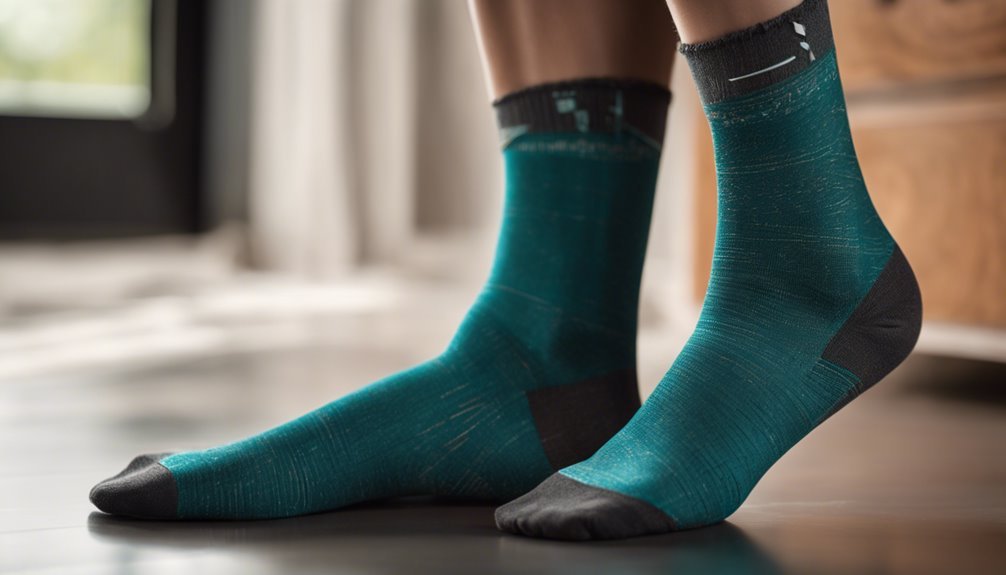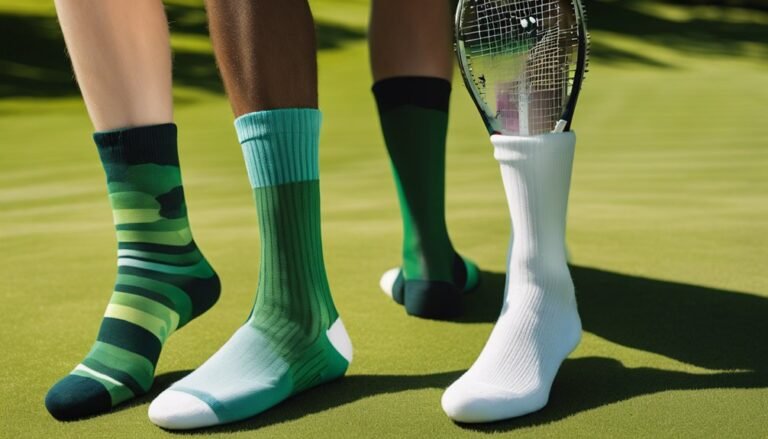Comrad vs. Copper Compression Socks: Which Improves Circulation?
Both Comrad and Copper compression socks can improve circulation, but they cater to different needs. Comrad socks focus on style and comfort while providing essential support to reduce fatigue and swelling. On the other hand, Copper socks incorporate copper for added anti-inflammatory benefits and may enhance healing. Your choice will depend on your specific requirements, whether it's fashion or therapeutic support. Discover more about their unique advantages to make an informed decision.
Understanding Compression Socks and Their Benefits

When you think about staying active or recovering from a long day on your feet, compression socks might not be the first thing that comes to mind, but they can make a significant difference. With a rich compression sock history dating back to ancient civilizations, these garments are designed to enhance circulation health. By applying gentle pressure to your legs, they help veins return blood to the heart, reducing fatigue and swelling. Studies show that wearing compression socks can improve athletic performance and speed up recovery time. Embracing these benefits allows you to reclaim your freedom to move without discomfort. So, whether you're running errands or hitting the gym, consider the positive impact compression socks can have on your daily life.
Overview of Comrad Compression Socks
While many compression socks focus solely on function, Comrad Compression Socks blend style with support, making them a popular choice for those seeking both comfort and fashion. These socks are crafted from high-quality materials that guarantee durability and breathability, so you can wear them all day without discomfort. Comrad's design features targeted support that promotes healthy circulation, alleviating fatigue and swelling in your legs. You'll appreciate the snug fit that hugs your calves without feeling restrictive. Plus, with a variety of stylish patterns and colors, you can express your personality while enjoying the benefits of compression therapy. Whether you're at work, traveling, or exercising, Comrad Compression Socks offer the freedom and support your legs deserve.
Overview of Copper Compression Socks
Copper compression socks are gaining attention for their unique blend of therapeutic benefits and comfort. Many people are turning to these socks for their purported copper properties, which are believed to enhance healing and reduce inflammation. The health benefits of wearing copper-infused compression socks include improved circulation, reduced muscle soreness, and relief from fatigue. These socks not only provide the traditional compression support but also offer the potential advantages of copper's antimicrobial and anti-inflammatory effects. You might find that wearing these socks during long periods of sitting or standing helps prevent swelling and discomfort. With their stylish designs and promising benefits, copper compression socks could be a great addition to your wellness routine, offering both comfort and support while you pursue your active lifestyle.
Comparing Compression Levels and Effectiveness

When choosing compression socks, understanding the differences in compression levels is essential for maximizing their effectiveness in improving circulation. Higher compression levels can provide more support but may not be suitable for everyone, depending on individual needs. Let's explore how these variations affect your comfort and circulation benefits.
Compression Level Differences
Understanding the differences in compression levels is essential to selecting the right socks for your needs. Compression levels are typically categorized as mild, moderate, and firm, each designed for specific conditions and activities. Mild compression (15-20 mmHg) is great for everyday wear, while moderate (20-30 mmHg) is ideal for those with more serious circulation issues. Firm compression (30-40 mmHg) is often recommended for medical conditions. Additionally, the sock materials play a significant role in comfort and breathability. Look for moisture-wicking fabrics to keep your feet dry and guarantee a snug fit without constriction. By understanding these factors, you can choose socks that not only support your freedom of movement but also promote better overall circulation.
Effectiveness in Circulation
While the compression level of your socks plays an essential role in their effectiveness, it's important to remember that individual needs can vary considerably. Different factors affect circulation improvement, and sock technology continues to evolve. Here are four key considerations:
- Compression Levels: Higher levels may benefit athletes, while lower levels suit everyday wearers.
- Sock Fit: Proper sizing guarantees the intended pressure across your legs.
- Material Quality: Breathable fabrics enhance comfort and promote longer wear.
- Duration of Use: Regularly wearing compression socks can lead to significant benefits over time.
Ultimately, finding the right balance between compression level and your unique needs can lead to ideal circulation improvement, allowing you to enjoy greater freedom in your activities.
Style and Design: Comrad vs. Copper Compression

Compression socks come in various styles and designs, and two popular brands—Comrad and Copper Compression—offer unique options that cater to different preferences. Comrad focuses on blending fashion trends with functionality, providing a range of vibrant color options and patterns that let you express your personality. Whether you prefer bold hues or subtle shades, Comrad guarantees you don't have to sacrifice style for comfort. On the other hand, Copper Compression leans towards a more classic look, featuring solid colors and a sleek design that appeals to those who appreciate simplicity. Both brands prioritize comfort and effectiveness, but your choice may ultimately come down to whether you value trendy aesthetics or timeless elegance in your compression wear.
The Role of Copper Infusion in Compression Socks
When it comes to compression socks, copper infusion is gaining attention for its potential benefits. You might wonder how the antimicrobial properties of copper compare to the traditional compression effects on circulation and recovery. Understanding these differences can help you make an informed choice about which socks are right for your needs.
Benefits of Copper Infusion
Copper-infused compression socks have gained popularity for their potential health benefits, often touted as a game-changer for those seeking relief from discomfort. The infusion advantages of copper provide several notable copper benefits that can enhance your overall well-being:
- Anti-inflammatory properties: Copper is known to reduce inflammation, which can ease pain and swelling.
- Antimicrobial qualities: Copper helps to combat bacteria, keeping your feet healthier and fresher.
- Enhanced circulation: The combination of compression and copper may improve blood flow, promoting better oxygenation.
- Skin health: Copper supports collagen production, which can lead to healthier, more resilient skin.
Embracing copper-infused compression socks means you're not just investing in comfort, but also in your health!
Compression vs. Copper Effects
While many people seek the benefits of compression socks for enhanced circulation and reduced swelling, the addition of copper infusion takes these advantages a step further. Copper properties, known for their antimicrobial and anti-inflammatory effects, can complement the principles of compression science. When you wear copper-infused socks, you're not just benefiting from the graduated pressure that promotes blood flow; you're also experiencing potential healing benefits. The copper may help reduce odor and inflammation, making your experience more comfortable. Additionally, some studies suggest that copper's natural qualities can aid in tissue repair, which could enhance recovery after physical activities. Ultimately, choosing between standard compression and copper-infused options comes down to your personal needs and how much you value those extra benefits.
Customer Reviews and Feedback
Although many people swear by the benefits of compression socks, customer reviews reveal a diverse range of experiences that highlight both the positives and potential drawbacks. Here are some key insights from user experiences:
- Improved Comfort: Many users report feeling more comfortable during long hours of standing or sitting, with noticeable relief in leg fatigue.
- Enhanced Performance: Athletes often praise the socks for boosting performance and recovery times.
- Fit and Sizing Issues: Some customers express dissatisfaction due to sizing inconsistencies, leading to discomfort.
- Durability Concerns: A number of reviews mention wear and tear after limited use, impacting overall user satisfaction.
These factors contribute to varying customer experiences, emphasizing the importance of finding the right fit for your individual needs.
Making the Right Choice for Your Needs
How can you guarantee you're choosing the right compression socks for your specific needs? Start by evaluating your personal preferences and lifestyle. Do you need socks for athletic performance, long hours at work, or post-surgery recovery? Each scenario may require different levels of compression and features.
Next, consider the material—some folks prefer breathable fabrics, while others might want moisture-wicking properties. Check the compression level; lighter compression is ideal for mild issues, while higher levels may be necessary for more serious conditions.
Lastly, don't forget to read customer reviews and feedback to gauge how the socks perform in real-world situations. By aligning your choice with your specific needs, you'll not only enhance circulation but also enjoy comfort and freedom in your daily activities.
Frequently Asked Questions
Can Compression Socks Be Worn During Exercise?
Did you know that 80% of athletes report enhanced exercise performance with compression socks? These socks, made from various materials, can support circulation and recovery during workouts, helping you feel more comfortable and perform better.
How Long Should Compression Socks Be Worn Daily?
You should wear compression socks for ideal wear daily duration of 6 to 8 hours. This helps improve circulation and reduces discomfort. Just listen to your body, and adjust the time based on your needs.
Are There Any Risks Associated With Wearing Compression Socks?
So, you think compression socks are all magic? Not quite! While they help, there're compression sock risks, like skin irritation or circulation problems. Always consult a professional to avoid potential side effects and keep your freedom intact.
Do Compression Socks Come in Different Sizes?
Yes, compression socks come in various sizes to guarantee proper fitting. Size variations cater to different leg measurements, providing ideal support. Choosing the right size can enhance comfort and effectiveness in promoting circulation and reducing swelling.
Can Pregnant Women Benefit From Wearing Compression Socks?
Yes, pregnant women can benefit from wearing compression socks. They offer pregnancy benefits like improved circulation support, reducing swelling and discomfort. Wearing them might enhance your overall comfort during this exciting, yet challenging, journey.







